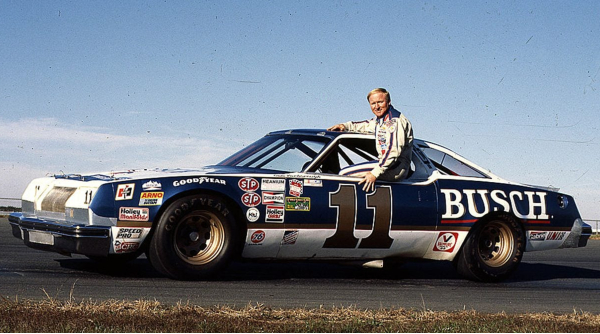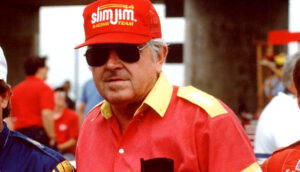NASCAR Legend Cale Yarborough Passes Away at Age 84

Cale Yarborough, a tenacious driver whose hard-charging style produced three NASCAR Cup Series championships, has died. He was 84.
Yarborough was a four-time Daytona 500 winner and a five-time victor in the Southern 500 – figures that rank second all-time for each crown-jewel event. His three Cup Series titles came consecutively from 1976-78; only Jimmie Johnson, who won five straight crowns from 2006-10, has claimed more titles in a row. Yarborough and Johnson are tied for sixth on the Cup Series’ all-time list with 83 victories each.
The rest of Yarborough’s life story veered between stock-car accomplishment and surreal folklore – with varying degrees of truth behind it – that underscored his toughness. Townsfolk in the South Carolina community of Sardis, where he settled, told the tales of how Yarborough survived a lightning strike, once flew and landed an airplane with no training and plucked water moccasins and wrestled an alligator in the Palmetto State swamps.
Yarborough is forever linked with the historic Darlington Raceway, the hard-edged track one county over where he made his big-league debut. Darlington honored Yarborough in 2016 by dedicating the same garage that he snuck into as a youth in his name. He was inducted into the NASCAR Hall of Fame in 2012 as part of the stock-car shrine’s third class of honorees.
“Cale Yarborough was one of the toughest competitors NASCAR has ever seen,” NASCAR Chairman & CEO Jim France. “His combination of talent, grit and determination separated Cale from his peers, both on the track and in the record book. He was respected and admired by competitors and fans alike and was as comfortable behind the wheel of a tractor as he was behind the wheel of a stock car. On behalf of the France family and NASCAR, I offer my deepest condolences to the family and friends of Cale Yarborough.”
William Caleb Yarborough was born March 27, 1939, as the oldest of Julian and Annie Yarborough’s three boys in Florence County, South Carolina. The family farmed tobacco and cotton, and Yarborough was driving a tractor to help with plowing by age 9. When his father was killed in a private airplane crash when Yarborough was 11, the youngster grew quickly into a more prominent role managing the family’s land and business affairs. The experience served him well in later years as a farmer, a businessman and a multiple-term member of the Florence County council, but he had designs on a faster-paced career.
“Somehow, I knew there had to be a better way to make a living than digging around in the dirt and picking tobacco worms off leaves by hand,” Yarborough said in 1988.
Yarborough followed other sporting pursuits in his youth, finding success as an amateur boxer and in football as a bullish, standout fullback. He received a football scholarship to Clemson under Coach Frank Howard, but moonlighted in racing at local tracks closer to home during the summer months. His first cars used his Timmonsville (S.C.) High School jersey number – No. 35.
When Yarborough told his coach that he needed to return for one final race to keep his edge in the track standings, Howard gave him an ultimatum.
“He said, ‘If you go back, pack your clothes, don’t come back. You either go and race or play football.’ So I packed my clothes and left,” Yarborough told reporters in 2008. “Of course, he kept calling. I told him, I said, ‘You told me to pack my clothes, and that’s what I did. I’m going to make racing my career.’ He says, ‘Son, you’ll starve to death.’ I said, ‘Well, I may.’
“In the end, Frank Howard is one of my biggest fans. He used to love to go to races and stand in my pits. I’ll never forget that he was at Talladega when I won a race there. He was in the winner’s circle. He walked up to me and put his hands on my shoulder and he always called me boy. He said, ‘Boy, I ain’t never been wrong many times in my life, but I want you to know I was wrong this time.’ “
Yarborough caught the eye of Darlington track president and general manager Bob Colvin at a soap-box derby race. He encouraged the young driver to make his Cup Series debut there in the 1957 Southern 500 as a teenager. He finished 42nd in the 50-car field, but not before drawing the ire of NASCAR officials for not meeting the era’s minimum age requirement of 20 years old. Yarborough fibbed on his license application, telling race organizers he was 21. His No. 30 Pontiac was flagged off the track after the ruse was uncovered, and officials realized that Yarborough and not team owner Bob Weatherly was behind the wheel.
His career looked bleak early on as he struggled to find a competitive ride. Yarborough took on jobs in logging and turkey farming to make ends meet and support his wife, Betty Jo, who he married at age 22. His prospects rose with his association with Ford and team owner Banjo Matthews in the mid-1960s. “Banjo helped me a lot,” Yarbrough said of the legendary car builder who provided his big break. “He gave me the first real good ride that I had.”
He scored his first Cup Series win at Valdosta, Georgia, while driving part-time for Kenny Myler in 1965, but Yarborough’s career became more established when he signed with the Wood Brothers three years later. Yarborough scored his first Daytona 500 win in 1968, edging Lee Roy Yarbrough by 50 feet. Months later, he added a victory in the Southern 500 at Darlington that he still held in high regard after his retirement.
“That was considered my home race track. That was on the old race track before they remodeled it,” he said. “I wouldn’t take that win for all the rest of ’em put together almost.”
Yarborough’s partnership with the Wood Brothers produced 13 Cup Series victories, but his future in stock-car racing was uncertain after Ford withdrew its factory support in 1970. By then, he had already dabbled in IndyCar racing, but made more of a go of it in the early ’70s paired with team owner Gene White. Yarborough notched his best Indianapolis 500 finish of 10th place in his fourth and final appearance in the race in 1972.
The following year, Yarborough made a full-fledged return to NASCAR, connecting with car owner Richard Howard and the legendary Junior Johnson, who served as the team’s manager and later its owner. Their eight-season partnership yielded some of Yarborough’s biggest successes – 55 wins, 39 pole positions and the run to three Cup Series titles. He was also the championship runner-up in three other seasons during that span, finishing second to Benny Parsons (1973), Richard Petty (1974) and Dale Earnhardt (1980).
“Cale never gave up under no circumstances,” Johnson told reporters in 1988. “He kept going after it.”
“Cale just dominated everything,” Petty told SpeedSport in 2019, referring to Yarborough’s time with Johnson. “He sat on the most poles and he won a ton of races. It was just his time. He was tough to race against whether he won championships or not. Of all the drivers running, he was probably the most determined driver there was. He would be 14 laps behind or 14 laps ahead, but he would pass every car he could see. He never gave up.”
That stretch of his career also linked him to one of the most dramatic races in NASCAR history, the 1979 Daytona 500. His last-lap duel with Donnie Allison resulted in a crash that eliminated both front-runners, clearing the way for a Petty victory. Yarborough fought with both Donnie and brother Bobby Allison in the infield at the crash site, an overflow of emotion that captivated viewers of the first NASCAR race televised live flag-to-flag.
“One Yarborough against two Allisons, that wasn’t even fair,” he said years later, able to smile about the incident after the passage of time. “But that’s the way it ended up. We were friends the next day and we’ve been friends ever since.”
Yarborough dialed back his racing schedule as he reached his 40s, citing a need to spend more time with his family. “Don’t get the idea that I plan to quit winning,” he told the Atlanta Journal-Constitution before the 1980 season finale, as a warning to the rest of the field. “I just plan to drive less and maybe win more.”
Yarborough won multiple races in each of those first five years as a part-timer, including back-to-back Daytona 500 wins in 1983 and 1984. The first of those came in a reserve car after a wild flip in qualifying demolished his primary No. 28 Harry Ranier-owned entry. The second came also by way of a last-lap slingshot pass, with CBS Sports’ in-car camera riding along and showing Yarborough pumping his first shortly after crossing the finish line.
He retired from full-time driving in what he described as a crossroads moment after the 1988 season, when he split driving duties with Dale Jarrett in cars he owned under the Yarborough Motorsports banner.
“I must have changed my mind 40 times on the way up here today, but I know deep down that it’s time to quit, and that’s what I’m going to do,” Yarborough said during his retirement announcement at Charlotte Motor Speedway, site of his last Cup Series win in 1985. “But it’s not like I’m giving up the sport. It would be impossible to just walk away. I’m going to be around, hopefully for a long time as a team owner.”
Yarborough spent the next 11 years involved in Cup Series team ownership, with a rotation of drivers filling the seat. John Andretti gave Yarborough his only win as a car owner, prevailing in Daytona’s 400-miler in July 1997.
He spent a quieter life on his 4,000-acre farm in later years, making occasional appearances at Darlington events. Yarborough was also a surprise guest at the 2008 NASCAR Awards banquet, congratulating Jimmie Johnson on tying his record of three consecutive championships, a mark he would break the next year.
“All records are going to be broken and tied. Tied, really, is all he’s done, so buddy, you’ve got some work to do,” Yarborough said to laughs from the gala crowd. “But if anybody was to tie my record, I’m glad Jimmie did it. He’s a great man, great race car driver and got a great future ahead of him.”
At the time of his retirement from driving, Yarborough counted restaurants, auto dealerships, textile interests, dry-cleaning franchises and his farming operation among his business interests. But he looked back ever fondly on his dream of chasing a career in racing, kick-started from sneaking into the Darlington garage for the second Southern 500 back in 1951.
“Racing is kind of like a big, tall ladder,” Yarborough said during his NASCAR Hall of Fame induction speech. “When you begin, you start off on the bottom step of that ladder, and it’s a long, hard climb to the top. But I feel like tonight that I’m finally standing on the top step.
Article by Zach Albert on NASCAR.com




